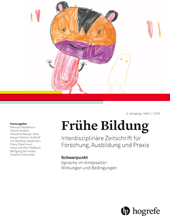Zusammenspiel sprachlicher und sozial-emotionaler Entwicklung vom vierten bis zum achten Lebensjahr
Eine längsschnittliche Untersuchung
Abstract
Zusammenfassung. Anhand längsschnittlicher Daten (N = 551) werden in diesem Beitrag die Entwicklungszusammenhänge zwischen sprachlichen und sozial-emotionalen Kompetenzen vom Eintritt in eine Kindertageseinrichtung (KiTa) bis zum Ende der ersten Klasse untersucht. Im Fokus steht die Frage nach der Wirkrichtung des Entwicklungszusammenhangs zwischen sprachlichen Kompetenzen und drei Bereichen sozial-emotionaler Kompetenzen, dem kooperativen Umgang mit Anderen, dem aggressiven Verhalten und der emotionalen Selbstregulation. Es zeigt sich, dass die Sprachkompetenz im Alter von drei Jahren nicht nur prädiktiv für alle drei Aspekte späterer sozial-emotionaler Kompetenzen ist, sondern darüber hinaus auch Entwicklungsveränderungen in diesen vorhersagt. Umgekehrt finden sich zwar auch Zusammenhänge zwischen dem frühen kooperativen und aggressiven Verhalten und der späteren Sprachkompetenz, jedoch sagen diese Aspekte des Sozialverhaltens keine Veränderungen in der Sprachkompetenz vorher. Erklärungsansätze und praktische Implikationen werden diskutiert.
Abstract. Based on longitudinal data (N = 551), the current study investigates the interplay between the development of language and socioemotional skills from entry into preschool to the end of first grade. We focus on the direction of effect between language competencies and three different aspects of socioemotional skills – cooperation, aggressive behavior, and emotional self-regulation. Results show that language competencies at the age of 3 years are related to later socioemotional competencies. In addition, early language predicts changes in socioemotional competencies. Although there is a relationship between early cooperative and aggressive behavior and later language competencies, these social skills do not predict changes in language competencies. Explanations and practical implications are discussed.
Literatur
et al. (2004). Early language impairment and young adult delinquent and aggressive behavior. Journal of Abnormal Child Psychology , 32 , 453 – 467.
(2003). The relationship between psychological understanding and positive social behaviors. Social Development , 2 , 198 – 221.
(1981). Peabody Picture Vocabulary Test – Revised (PPVT-R) . Circle Pines, MN: American Guidance Service.
(2007). Language, social behavior, and the quality of friendships in adolescents with and without a history of specific language impairment. Child Development , 78 , 1441 – 1457.
(2006). Test zur Überprüfung des Grammatikverständnisses (TROG-D) . Idstein: Schulz-Kirchner.
(1996). Internationally comparable measures of occupational status for the 1988 international standard classification of occupations. Social Science Research , 25 , 201 – 239.
(1994). Influence of communicative competence on peer preferences in a preschool classroom. Journal of Speech and Hearing Research , 37 , 913 – 923.
(2001). Sprachentwicklungstest für drei- bis fünfjährige Kinder (SETK 3 – 5) . Göttingen: Hogrefe.
(2009). Bildungsprozesse, Kompetenzentwicklung und Selektionsentscheidungen: Die interdisziplinäre Längsschnittstudie BiKS im Überblick. SAL-Bulletin , 131 , 5 – 20.
(2004). The relationship between language and social competence: How language impairment affects social growth. Psychology in the Schools , 41 , 313 – 321.
(2006). Contemporaneous and longitudinal associations between social behavior and literacy achievement in a sample of low-income elementary school children. Child Development , 77 , 103 – 117.
(2012). Mplus user's guide ( 7. Aufl. ). Los Angeles, CA: Muthén & Muthén.
(2009). Funktionale Relevanz und Mikrogenese selbstbezogener Sprache im Vorschulalter . Berlin: Logos.
et al. (2013). Language ability predicts the development of behavior problems in children. Journal of Abnormal Psychology , 122 , 542 – 557.
(1993). Social consequences of specific language impairment. In H. Grimm & H. Skowronek (Eds.), Language acquisition problems and reading disorders: Aspects of diagnosis and intervention (pp. 111 – 129). Berlin: Walter de Gruyter.
(2005). Peabody Picture Vocabulary Test (PPVT) (unveröffentlichte deutsche Forschungsversion des PPVT-R von L. M. Dunn & L. M. Dunn, 1981). Universität Bamberg/Freie Universität Berlin.
(1985). Behaviour problems and language abilities at three years and behavioural deviance at eight years. Journal of Child Psychology and Psychiatry , 26 , 215 – 230.
(2000). Gender differences in the relationship of language development to disruptive behavior and peer relationships in preschoolers. Journal of Applied Developmental Psychology , 20 , 521 – 536.
(2005). Snijders-Oomen Non-verbaler Intelligenztest (SON-R 2½-7) . Lisse: Swets & Zeitlinger.
(1992). The social bases of language acquisition. Social Development , 1 , 67 – 87.
(2014). Socio-emotional skills, behavior problems, and Spanish competence predict the acquisition of English among English language learners in poverty. Developmental Psychology , 50 , 2242 – 2254.



